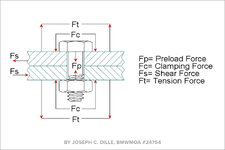EngTipsAccount1234
Mechanical
- Sep 30, 2024
- 8
Say you have a bolt going through an unthreaded hole in a plate, then into a second plate with a hole that is threaded. You are trying to hold the two plates together with this connection. Is the bolt being stretched at all to create a preload or clamping force? If not then what is keeping these two pieces together when an external load is applied?
For a connection with a bolt and nut I understand that the nut stretches the bolt to create a clamping force. But I don't understand how that clamping force would arise in a connection without a nut like I described. Yet this connection is used all the time to hole parts together.
For a connection with a bolt and nut I understand that the nut stretches the bolt to create a clamping force. But I don't understand how that clamping force would arise in a connection without a nut like I described. Yet this connection is used all the time to hole parts together.

